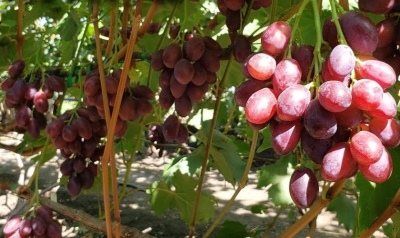
- Authors: Kalugin Viktor Mikhailovich
- Appointment: dining room
- Berry color: red-burgundy
- Taste: harmonious, light nutmeg
- Ripening period: early middle
- Ripening period, days: 110-115
- Frost resistance, ° C: -23
- Bunch weight, g: 700-1000
- Flower type: bisexual
- Density of the bunch: loose
Knyazhna grape is a relatively new variety. To grow it, you must carefully study its features. Both the organization of the planting and other actions for caring for the bushes are of great importance.
Breeding history
The development of the variety was carried out by the famous breeder V.M. Kalugin. The aim of the work was to obtain a new table fruit plant. The year of cultivation of the variety is unknown.
Description
Knyazhna grape is one of the novelties of the grape world. This plant is still being tested. Resistance to diseases, high consumer qualities and opportunities for growing make the Princess a very promising choice. Kalugin himself insists that this is one of his best designs. The plant is suitable for most of the Russian territory.
Ripening period
The culture belongs to the early middle group. The formation of fruits after planting or the beginning of the growing season usually takes 110-115 days. In a particular year, meteorological conditions can either shorten or lengthen this period. You can expect the ripeness of the berries by the beginning of autumn.
Bunches
Many brushes resemble a cylinder in shape, but there are also clusters devoid of a clear shape. They branch out in a completely arbitrary and bizarre way. The berries are loosely collected in the brush. The weight of each bunch varies from 0.7 to 1 kg.
Berries
They are characterized by a red-burgundy color. Skin thickness is moderately dense. In shape, the fruits are oval and resemble spindle externally. The thickened area is located in the middle. The berry mass reaches 16 g, according to some sources up to 20 g.
Taste
The princess leaves a harmonious taste sensation. It belongs to the nutmeg group of varieties. The fleshy flesh is quite firm. The peel does not affect the taste. Berries collect a lot of sugar.
Yield
Young princess bushes give clusters weighing up to 0.4 kg, adults - up to 0.7-1 kg. Fertility is fairly stable. It is known that 3 inflorescences can fall on 1 shoot.


Growing features
The variety needs careful care. The plant's resistance to various conditions does not allow you to rely on luck. The recent appearance of the variety does not yet make it possible to form individual recommendations. Saplings should have lignified roots. The distance between plants is 2 m.
Landing
When landing, it is useful to build on the general recommendations:
- choose a warm and dry place protected from the winds;
- be guided by weather conditions;
- plant a crop using a vegetative seedling;
- exclude planting in the immediate vicinity of fences, houses and other buildings;
- keep a distance of 4 m from other fruit plants.

Pollination
The plant has bisexual flowers. Under normal conditions, no special pollination procedures are required. In some cases, in very bad weather, they are resorted to as a last resort.
Pruning
The Princess must be cut short. Medium pruning is sometimes done. The choice of a specific option is determined by the state of the bush and the problem solved by gardeners. The degree of maturity of a particular plant is also taken into account. The higher the load on it, the more actively you need to unload, so that the maximum of the fruitful force is spent on the necessary shoots.

Watering
It is permissible to practice both surface and underground watering. It is possible to irrigate grapes superficially only where young seedlings grow. Adult cultures have many deep roots, and for them this method is of little use. Irrigation schedules are based on land conditions and predicted rainfall.


Frost resistance and the need for shelter
Cold season resistance is not yet fully understood. There are a number of statements that at -23 ° the Princess hibernates well. However, this has to be confirmed or refuted additionally. It is worth noting that even if all the promises are correct, frost protection is still needed in most of the Russian territory. Specific shelter procedures have not yet been developed.

Diseases and pests
Resistance to fungal pathologies is above average. However, this does not exempt from the need to carry out preventive treatments. Disease resistance has not yet been fully explored. Therefore, maximum precautions are required. Anti-pathology measures are the same as for other varieties.

If a grape is exposed to any disease or insect, this always affects its appearance.
Storage
The high sugar content greatly complicates the preservation of these fruits for a long time. It is hardly possible to achieve this outside the refrigerator. Even in this case, it will not be possible to save the harvest for more than 2-3 months. Short accumulation is only possible in cool, shaded areas. Processing, including into wine, is an alternative.











































































